Barmouth Bridge
Barmouth Bridge (Welsh: Pont Abermaw), or Barmouth Viaduct is a Grade II* listed single-track wooden railway viaduct across the estuary of the River Mawddach near Barmouth, Wales. It is 699 metres (764 yd) long and carries the Cambrian Line. It is the longest timber viaduct in Wales and one of the oldest in regular use in Britain.
Barmouth Bridge Pont Abermaw | |
|---|---|
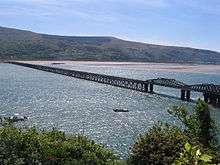 View of the bridge from Barmouth | |
| Coordinates | 52.714°N 4.039°W |
| Carries | Rail traffic, pedestrians |
| Crosses | Afon Mawddach |
| Locale | Gwynedd, Wales |
| Heritage status | Grade II* listed |
| Characteristics | |
| Total length | 699 metres (764 yd) |
| History | |
| Opened | 1867 |
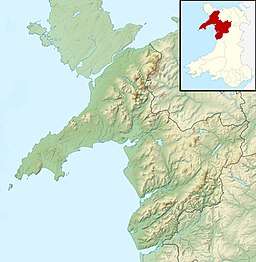 Barmouth Bridge Location within Wales 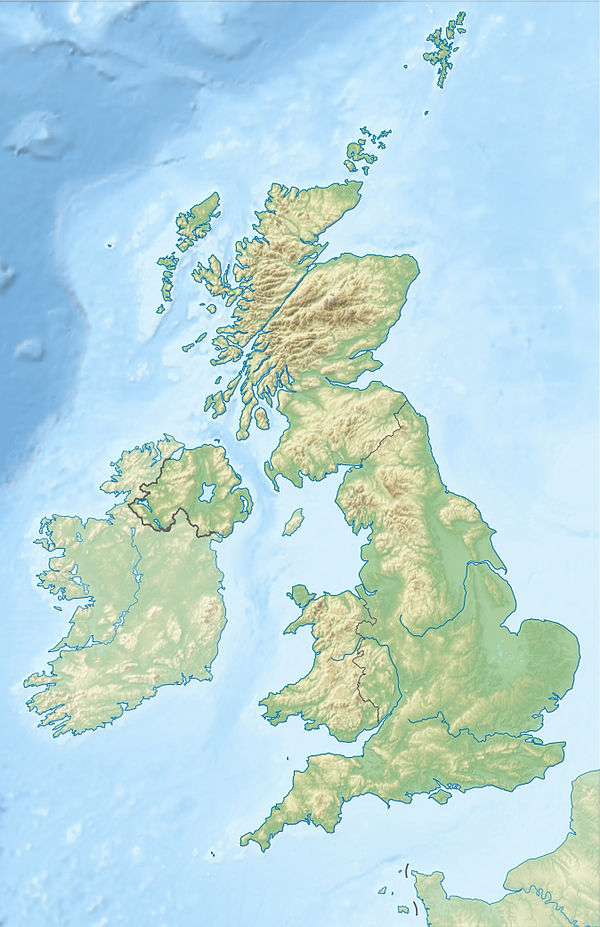 Barmouth Bridge Barmouth Bridge (the United Kingdom) | |
Barmouth Bridge was designed by and constructed for the Aberystwith and Welsh Coast Railway on its line between Aberystwyth and Pwllheli. Work was authorised in 1861 and commenced in 1864. On 10 October 1867, the completed bridge was officially opened. Following the discovery of severe corrosion on underwater sections of ironwork, an intensive restoration programme was performed between December 1899 and late 1902. By 1980, the viaduct was under attack by marine woodworm, which led to concerns that it would have to be closed and demolished. Because of its value to tourism, it was repaired between 1985 and 1986 when it was closed for six months. Since 2005, weight restriction on the bridge have been relaxed, allowing locomotive-hauled trains to cross for the first time in two decades.
The bridge between Morfa Mawddach and Barmouth in Gwynedd, is used by rail, cyclists and pedestrians and is part of the National Cycle Network. To allow the passage of tall ships, the bridge incorporated a drawbridge, which was replaced between 1899 and 1902 by a swing bridge which is no longer operational due to a lack of demand. There is no provision for road traffic. Tolls were collected for foot and cycle traffic up to 2013 but this has been voluntary since 2017.
Location
Barmouth Bridge crosses the estuary of the River Mawddach between Morfa Mawddach near Arthog on the south and Barmouth.[1] The line was operated by Arriva Trains Wales until 2018, and is now operated by Transport for Wales, which provides connecting services south to Aberystwyth and east to Welshpool and Shrewsbury.[2] The bridge is on the Cambrian Coast railway between Machynlleth and Pwllheli.[3] It is 699 metres (764 yd) long,[4][5] and is made up of 113 wooden trestles, supported by cast iron piers. It is one of the longest timber viaducts standing in Britain,[4][6] and is a Grade II* listed structure.[7]
Most of the bridge is built on top of a gravel bed, covered by shifting sand. The northern end of the viaduct, where the swing bridge is located, is next to Figle Fawr a rock at the base of the Rhinogydd mountain. Water passing through the channel flows at up to 9 knots (16.7 km/h). The first two spans at this end are built on the rock on cast iron cylindrical piers.[4] The steel swing bridge section, which replaced the original drawbridge,[8] was last opened (for testing) in April 1987.[4] The installation of continuous rail across the movable section now prevents its movement, and the passage of tall ships in and out of the estuary.[9]
The nearest road across the Afon Mawddach is the toll bridge at Penmaenpool about 5 miles (8 km) upstream, which can carry vehicles up to 2.5 tonnes. Heavier vehicles must use the first public road bridge, at Dolgellau, about 10 miles (16 km) from Barmouth.[10]
Pedestrians, cyclists and motorcycles can cross the estuary via the footbridge on the bridge's eastern side.[5] Since 1996, the footbridge has been part of the National Cycle Route linking North and South Wales.[1] The footbridge is owned by Network Rail, and Gwynedd County Council contributes 10 per cent of its annual maintenance in exchange for a licence to use it.[11]
History
Background and construction
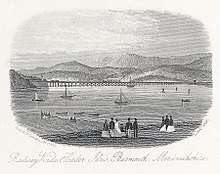
A bridge across the Mawddach Estuary at Barmouth was proposed by the Aberystwith and Welsh Coast Railway, who constructed a line between Aberystwyth and Pwllheli.[4] Authorisation for the railway was received in 1861 - 2 and the detailed design of the bridge was started.[4]
Barmouth Bridge was designed by the civil engineers Benjamin Piercy and Henry Conybeare.[4] Conybeare wanted a timber viaduct because it was about four times cheaper to import wood from the Baltic by sea than to construct an iron bridge.[4] The decision was influenced by the incorrect belief that the estuary was free from marine borers, which attack and weaken the timber over time. During this era, timber pile viaducts were commonplace on coastal railways, particularly in Wales, although the bridge at Barmouth would be longer than most.[4]
Construction began in 1864.[4] The contractor was Thomas Savin, and the ironwork was produced by John Cochrane & Sons. Early on, progress was hindered by strong tidal currents which caused multiple failed attempts to sink the bridge's piers from barges.[4] Between March and June 1866, staging was built from the northern abutment for the bridge, and the piers were dropped into the water and filled with concrete.[4]

Wooden trestles were built on screw piles 10 inches (250 mm)-14 inches (360 mm) wide with screw discs 36 inches (910 mm) in diameter in groups of three piles per pier.[4] Timber trellis girders, 40 feet (12 m) long and 4 feet (1.2 m) deep, supported the deck, with driven piles as fenders. The water around the trestles had a maximum depth of 54 feet (16 m) at spring tides but the river bed was raised by tipping stones to protect the piles.[4]
The viaduct had a 47 feet (14 m) wooden drawbridge near its northern end allowing tall ships to pass upstream.[4] The drawbridge span, which was carried on top of wrought iron piles, opened by tilting and rolling back over the track on four 4 feet (1.2 m) wheels, spaced 50 feet (15 m) apart, and nine steel rollers. When opened, there was a 36 feet (11 m) gap between the fenders.[4] The drawbridge never regularly used as the opening of the railway effectively eliminated the need for traditional boat traffic.[12]
On 3 June 1867, horse-drawn carriages crossed the viaduct. On 10 October, the bridge was officially opened, and steam-hauled services started.[4]
Operational life
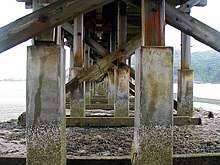
In August 1899, Alfred Jones Collin, the chief engineer of the Cambrian Railways ordered underwater inspections to check the integrity of the drawbridge span’s ironwork.[4] They discovered that the supports were severely corroded, undermining its structural integrity and requiring the replacement of all the ironwork except for two piers. A temporary speed limit of 5 miles per hour (8.0 km/h), later reduced to 2 miles per hour (3.2 km/h), was put in place while repairs were made.[4] Repairs started that December and were completed by the end of 1902.[4] The drawbridge was replaced with a swing bridge with a single steel swing span, 41.5 meters long, which rotated around a central pivot, adjacent to a 36 meter-long fixed span.[4] The spans are hogback lattice trusses, supported by pairs of cylindrical iron piers, and the turntable rests on a cluster of four piers.[4]
In 1946, the bridge was nearly destroyed after a live naval mine was washed ashore close to it during stormy weather. According to reports, the mine had swept past one of the pillars, but did not detonate and the bridge escaped unscathed.[13]
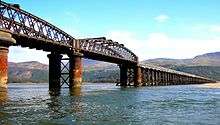
Following the Beeching cuts of the 1960s, passenger train services declined after the closure of the Ruabon to Barmouth line via Llangollen and Dolgellau in 1965, causing all traffic to take the longer and slower route from Shrewsbury via Machynlleth and Dovey Junction.[4] The old trackbed from Morfa Mawddach railway station to Dolgellau now forms the Mawddach Trail, a walking and cycle trail.[14]
By 1980, the bridge was under attack from marine woodworm and the resulting damage was serious enough to threaten its closure.[15] British Rail discovered that woodworm had eaten into 69 of the supporting pillars and estimated that it would cost around £2.5 million to repair.[16] Locomotive-hauled trains were banned, which resulted in the loss of traffic from Tywyn, including explosives traffic to and from the factory at Penrhyndeudraeth which was re-routed via Maentwrog Road railway station and the Conwy Valley Line.[17] Gwynedd County Council opposed closing the bridge as 40% of all railway traffic in the area was tourist related.[15] The government applied for a £2.5 million grant from the European Economic Community (EEC) to finance repairs,[18] and £4.6 million was spent on signalling improvements upon the line.[15] The bridge was closed to traffic for six months during the repair works and 30 of the piles were replaced.[16]
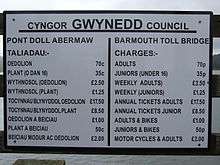
On 13 April 1986, a British Rail Class 37 diesel locomotive number 37427 was named "Bont Y Bermo" to celebrate the re-introduction of locomotive-hauled trains following repairs in 1985–1986. Locomotive-hauled trains were forbidden shortly afterwards after weight restrictions were imposed upon all bridge traffic. After major repairs in 2005, the weight restriction was relaxed and locomotive-hauled trains are allowed to cross.[19]
In March 2013, the Barmouth Viaduct Access Group (B-VAG), was established to investigate an alternative route from the town centre to the bridge, as the walkway is steep, narrow, and unsuitable for buggies or wheelchairs.[20] In June, the bridge toll was removed after the collectors left and were not replaced. The council is undecided as to how to pay for maintenance costs, which were £39,405 for the year.[5] This is problematic as revenue from tolls is insufficient to cover the council's share of costs, and there is no budget to employ staff to collect payments.[11]
Gwynedd Council proposed closing the bridge to pedestrians and cyclists for cost reasons, as it needed to find £9 million of savings by April 2016. Closing the bridge is one of over 100 cost saving options totalling £13 million that were put to a public consultation in Autumn 2015. The council pays Network Rail £30,800 per year towards maintenance costs. A petition calling on the council to "cease considerations of closing this much loved walking and cycling route" attracted 20,000 signatures in a week.[21][22] In February 2016, it was reported that the bridge would not close.[23]
On 4 October 2016, Barmouth Bridge was closed to traffic for a week following a fire on the structure.[24] The following day, MP Liz Saville Roberts lobbied for its speedy renovation as a matter of urgency.[25]
The viaduct celebrated its 150th anniversary in October 2017 with a fireworks display and special charter trains were run.[26] The same month, Bill Kelly, the chief operating officer of Network Rail Wales, spoke of unapproved ambitions to spend around £20 million to secure the long-term future of Barmouth Bridge between 2019 and 2024.[27] In late 2017, an "honesty toll" of £1 for adults and 50p for children was introduced with a troll mascot, and the old toll house rebranded as a "troll house".[28]
In December 2018 it was reported that the future of the bridge is once again in doubt.[29]
In May 2020, a £25m restoration was announced by Network Rail.[30]
See also
- List of bridges in Wales
- Pont Briwet, a former 19th-century timber viaduct built by the Aberystwith and Welsh Coast Railway.
References
Citations
- Gwynedd County Council 2013, p. 1.
- "Cambrian Line". Arriva Trains Wales. Archived from the original on 9 October 2014. Retrieved 6 October 2014.
- "Cambrian Coast Railway Line". Aberystwyth Town Council. Retrieved 6 October 2014.
- "Barmouth Viaduct". Engineering Times. Archived from the original on 15 October 2014. Retrieved 9 October 2014.
- "Barmouth Bridge in Gwynedd toll-free as staff leave". BBC News. 11 June 2013. Retrieved 6 October 2014.
- Breverton, Terry (2012). Wales: A Historical Companion. Amberley Publishing Limited. p. 54. ISBN 978-1-4456-0990-4.
- "Barmouth Railway Bridge,(Partly in Arthog Community) Barmouth Bridge, Barmouth Date Listed: 22 March 1988 Cadw Building ID: 5207". British Listed Buildings. Retrieved 10 April 2016.
- Clemens 2003, Trial opening, 19 mins from start.
- "Continuous rails across the bridge". www.google.com/maps. 3 January 2018.
- Green, Jim (2000). Holy Ways of Wales. Y Lolfa. p. 117. ISBN 978-0-86243-519-6.
- Gwynedd County Council 2013, p. 2.
- Hollingsworth, John Brian (1982). Atlas of the World's Railways. Bison. p. 72.
- "Barmouth Viaduct". Western Morning News. 23 April 1946. p. 2. Retrieved 8 November 2014 – via British Newspaper Archive.
- "Mawddach Trail". Snowdonia National Park Authority. Archived from the original on 15 October 2014. Retrieved 9 October 2014.
- Evan Evans, Lord Mountevans (26 February 1986). "Settle/Carlisle Railway: Proposed Closure". Retrieved 7 October 2014.
- Pearce, Fred; Hamer, Mick (12 May 1983). "The Empire's Last Stand". New Scientist: 387. Retrieved 9 October 2014.
- Baughan, Peter (1991). North and Mid Wales, Volume 11 of Regional Railway History Series. David St. John Thomas. p. 246. ISBN 978-0-946537-59-4.
- "European Community Loans and Grants". Hansard. 30 June 1980. Retrieved 7 October 2014.
- "The Railway Magazine" (149). 2003: 57. Cite journal requires
|journal=(help) - "New harbour walkway planned for Barmouth". Cambrian News. 28 March 2013. Archived from the original on 15 October 2014. Retrieved 9 October 2014.
- "20,000-name petition to keep Barmouth Bridge open to all". BBC News. 20 August 2015. Retrieved 21 August 2015.
- Devine, Darren (20 August 2015). "Fight to save Barmouth Bridge sees 20,000 sign petition within a week". Wales Online. Retrieved 21 August 2015.
- "Caernarfon and Barmouth bridges SAVED from the axe..." Daily post. 8 February 2016. Retrieved 1 June 2016.
- "Fire on Barmouth Bridge viaduct leads to rail disruption." BBC News, 4 October 2016.
- "Fire-hit Barmouth Bridge 'Renovations Urgent' says MP." Daily Post, 5 October 2016.
- "Crowds wowed by firework spectacle at Barmouth Bridge 150th anniversary celebrations". Daily Post Wales. 15 October 2017.
- "Barmouth Bridge £20m plan on its 150th anniversary". BBC News. 10 October 2017. Retrieved 17 August 2018.
- "Voluntary donation to 'troll' under bridge". Cambrian News. 22 December 2017. Retrieved 14 September 2018.
- "Future of 150-year-old bridge in doubt again". Cambrian News. 13 December 2018. Retrieved 24 December 2018.
- https://www.networkrailmediacentre.co.uk/news/network-rail-begins-biggest-restoration-of-barmouth-viaduct-in-its-history
Bibliography
- Report to Cabinet : Barmouth Bridge (PDF) (Report). Gwynedd County Council. 11 June 2013. Retrieved 27 October 2016.
- Clemens, Jim (2003) [1959]. North Wales Steam Lines (DVD). The Jim Clemens Collection No.6. Uffington, Shropshire: B&R Video Productions. Vol 79.CS1 maint: ref=harv (link)
External links
| Wikimedia Commons has media related to Barmouth Bridge. |